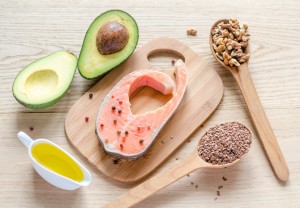Fat
Fat is a source of energy (kilojoules) and essential fatty acids in our diets. It is also used in our bodies as insulation to keep us warm, protection for our vital organs and to carry fat-soluble vitamins. Fat is naturally found in animal products (meat and dairy), nuts, seeds, grains and some fruits such as olives and avocados. It is also added to many processed foods. Fat contains the most kilojoules (kJ) per gram (37 kJ) when compared with carbohydrates, protein and alcohol.
There are two types of fat, unsaturated and saturated fat. Both have very different effects on our health. However, it is important to remember that when eaten in large amounts, all fats contribute the same amount of energy (kilojoules) and can contribute to weight gain.
Unsaturated fats
Unsaturated fats are often called ‘healthy fats’ as they help reduce heart disease and lower cholesterol levels. These fats are liquid at room temperature. There are two types of unsaturated fats, polyunsaturated and monounsaturated.
Monounsaturated fats are found in olive oil, canola oil, avocados and nuts. Replacing saturated fats in the diet with monounsaturated fats can help to lower cholesterol levels.
Polyunsaturated fats include omega-3 and omega-6 fats that have slightly different health benefits. Omega-3 fats are found in oily fish, eggs, linseed, walnuts and soybeans and have been shown to be protective against heart disease. Omega-6 fats are found in nuts, sunflower seeds, sunflower and sesame oil and margarine spreads. They have been shown to decrease the risk of heart disease when consumed in place of saturated fats.
Saturated fats
Saturated fats are considered ‘unhealthy fats’ as overeating them can contribute to high cholesterol levels and heart disease risk. These fats are generally solid at room temperature except for palm and coconut oil. Saturated fat is the primary type of fat found in milk, cream, butter, cheese, meat, palm oil and coconut oil.
Trans-fats
Trans-fats are found in some pastries, biscuits and fast foods, and are classified as discretionary foods in the Australian Guide to Healthy Eating. Trans-fats are unsaturated fats that behave similarly to saturated fats in the body because of their chemical shape. They can be found naturally occurring in some foods or processed foods. Trans-fats are produced during some manufacturing processes and have been found to be more harmful than saturated fat to heart health. For this reason, trans-fats should be avoided in the diet and replaced with mono or polyunsaturated fats where possible.
When choosing packaged foods, look for those lower in saturated fat and minimal to zero trans-fats. Avoid foods that contain ”hydrogenated oils” or “partially hydrogenated vegetable oils” in the ingredients list.
Cholesterol is needed by the body to transport fats, provide structure to cell membranes and to make hormones and some vitamins such as vitamin D. Our body produces all the cholesterol we need, so it’s not essential in our diet. It is important to remember though, that eating cholesterol in our diet only raises blood cholesterol levels a little, and not as much as eating saturated and trans fats. Often though, foods high in cholesterol also contain trans-fats and are high in saturated fat.
How to reduce saturated fats in the diet
• Swap full-fat dairy foods for reduced or low-fat dairy foods for all family members over the age of 2
• Swap butter for margarine spread made from canola, sunflower or olive oil
• Where possible, bake, roast or steam food instead of frying
• Trim all visible fat from meat, remove the skin from chicken and try to avoid processed meat (e.g. sausages and salami)
• Limit cakes, pastries, biscuits and high fat snack foods such as chips. Encourage kids to view these foods as a special occasion rather than everyday foods
• Limit take away and fast food to a maximum of once per week
How much unsaturated fat should I include in my child’s diet?
Including small amounts of polyunsaturated and monounsaturated spreads and oils or small amounts of nuts and seeds can provide essential fatty acids and some fat-soluble vitamins. However, unsaturated fat is also high in energy (kilojoules), so it is important to keep quantities small to balance with total energy needs. For school-age children, the recommendation from the Australian Guide to Healthy Eating is as follows:
• 2 serves (14-20g) per day for adolescents 14-18 years of age
• 1 ½ serves (11-15g) per day for children 12-13 years
• 1 serve (7-10g) per day for children 3-12 years
A serve is equivalent to:
• 10g polyunsaturated or monounsaturated spread
• 7g polyunsaturated oil, e.g. olive or canola oil
• 10g tree nuts or peanuts or nut pastes/butter







